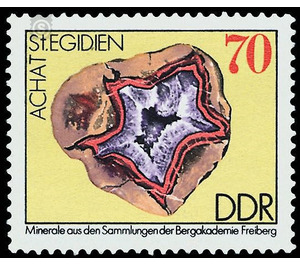Commemorative stamp series - Germany / German Democratic Republic 1974 - 70 Pfennig
Theme: Geology & Geography
| Country | Germany / German Democratic Republic |
| Issue Date | 1974 |
| Face Value | 70.00 |
| Color | brown yellow |
| Perforation | K 14 |
| Printing Type | Rotogravure 2 |
| Stamp Type | Postage stamp |
| Item Type | Stamp |
| Chronological Issue Number | 1753 |
| Chronological Chapter | GER-DDR |
| SID | 832215 |
| In 19 Wishlists | |
Minerals from the Collections of the Bergakademie Freiberg The Ministry of Posts and Telecommunications of the German Democratic Republic publishes six multicolored special postage stamps showing minerals from the collections of the Bergakademie Freiberg. Minerals from the Collections of the Bergakademie Freiberg The motifs of the new stamp series differ from the previous issues (May 21, 1965 and March 22, 1972) with mineral representations through the processing of the material. All find points of the minerals, which are used for jewelery or decoration purposes, lie in the GDR. Some of them are world famous (Schneckenstein) and have been used for centuries in the sense mentioned. It is worth remembering at this point to the cultural-historical-valuable objects of the Saxon royal family and other dynasties with polished wine-red topazes from the Schneckenstein, which are exhibited in the Green Vault in Dresden. But also abroad, agates and amethysts from Saxony have been used to decorate well-known buildings. Thus, in the Wenceslas Chapel in Hradschin in Prague and at Karlsteyn Castle in Bohemia, these minerals from Erzgebirge are to be found. Since the old sites are partially exhausted, more agate and amethyst foundations have been discovered in recent times by working in the field and by references from the literature with remarkable quality of the mineral species in color and form to the delight of many collectors. Some of the minerals of the most famous localities in the GDR, which are characterized by particular beauty, but also rarity, are depicted on the six values of the stamp series. 10 Pfennig value: Band Jasper (Quarzabart) of Gnandstein at Kohren-Sahlis, Bez. Leipzig. (MiSa No. 62 626), size of the piece: 90 x 70 x 50 mm Due to the different brown shades of the bands, the jasper looks very decorative after sanding and polishing. Interesting are the well recognizable distortions caused by tectonic movements. The bends are due to the different stratification of the silicified Porphyry tuff from the red. 15 Pfennig value: smoky quartz (color code of the quartz - Si02 pitchle green in the Vogtland (MiSa No. 34 891), size of the stone: 18 x 14 x 8 mm smoky quartz can not be counted among the rare gemstones, because in many pegmatites are Crystals of considerable size with quite different shades to find.To improve the value is often the name "smoky topaz" to find.When compared to the alpine occurrences, our local finds with schleifwürdigen games are still considered to be low.The gemstone has a special kind of facet cut, 20 Pfennig value: Topas (Al2 [F2Si04)) of the Schneckenstein in the Vogtland (MiSa No. 59 164), size of the stone: 10 x 7 mm The Topas is due to its hardness (8) and its Color difference often worn as a gemstone. Very much sought after are the weenelben Topase of the Schneckensteins, which produce a maximum of brilliance when using the brilliant cut. The dark inclusions of ilmenorutil or gas inclusions and cracks have a negative impact on value. 25 Pfennig value: Amethyst (color code of the quartz) with quartz of Geyer in the Erzgebirge (MiSa No. 63 142), size of the piece: 160 x 90 x 60 mm The strongly blue colored variety of the quartz is always very much desired, whereby the crystals from the American states of Brazil, Uruguay and Mexico occupy a special position with regard to quality. Our indigenous deposits have extremely rare sanding games and are mainly refined by grinding, whereby the visual effect is enhanced by the color different zones. The amethyst crystals of Geyer are occasionally encrusted with milky quartz, and in small druses mulgenous manganese and iron ores are embedded. 35-pfennig value: aquamarine (Al2Be3 [Si6018]) from Irfersgrün in Vogtland (MiSa No. 63 384), size of the stone: 14 x 10 x 7 mm The water-clear blue to greenish variety of beryl is in the pegmatite of the Vogtland so far been found in a few, good quality pieces. The stepligen crystals are strongly corroded and fused with feldspar, so that schleifwürdiges material is extremely rare. From this point of view, this occurrence should be considered a rarity. The cut shape is also assigned to that of the scissors cut. 70 Pfennig value: Agate (Quarzabart) in the porphyry of St. Egidien near Glauchau / Sa. (MiSa No. 39 206), size of the hemisphere: 90 x 80 x 40 mm The agates are characterized by diversity in shape and color, with the red and bluish tones prevail. From time to time, the agates contain small quartz glands, which still shimmer red to purple through iron minerals. The agate bands vary greatly in their strength, as well as the porphyry balls in their size, which have often included two or more agates. From this reference, in addition to the agate balls and bandachains are known, which are in no way inferior by their drawing and coloring. The selection represents only some of the known and recent occurrences of agates and quartz varieties in our republic. The number could be expanded significantly, but even the few examples give a good impression of the diversity and beauty of these minerals.


